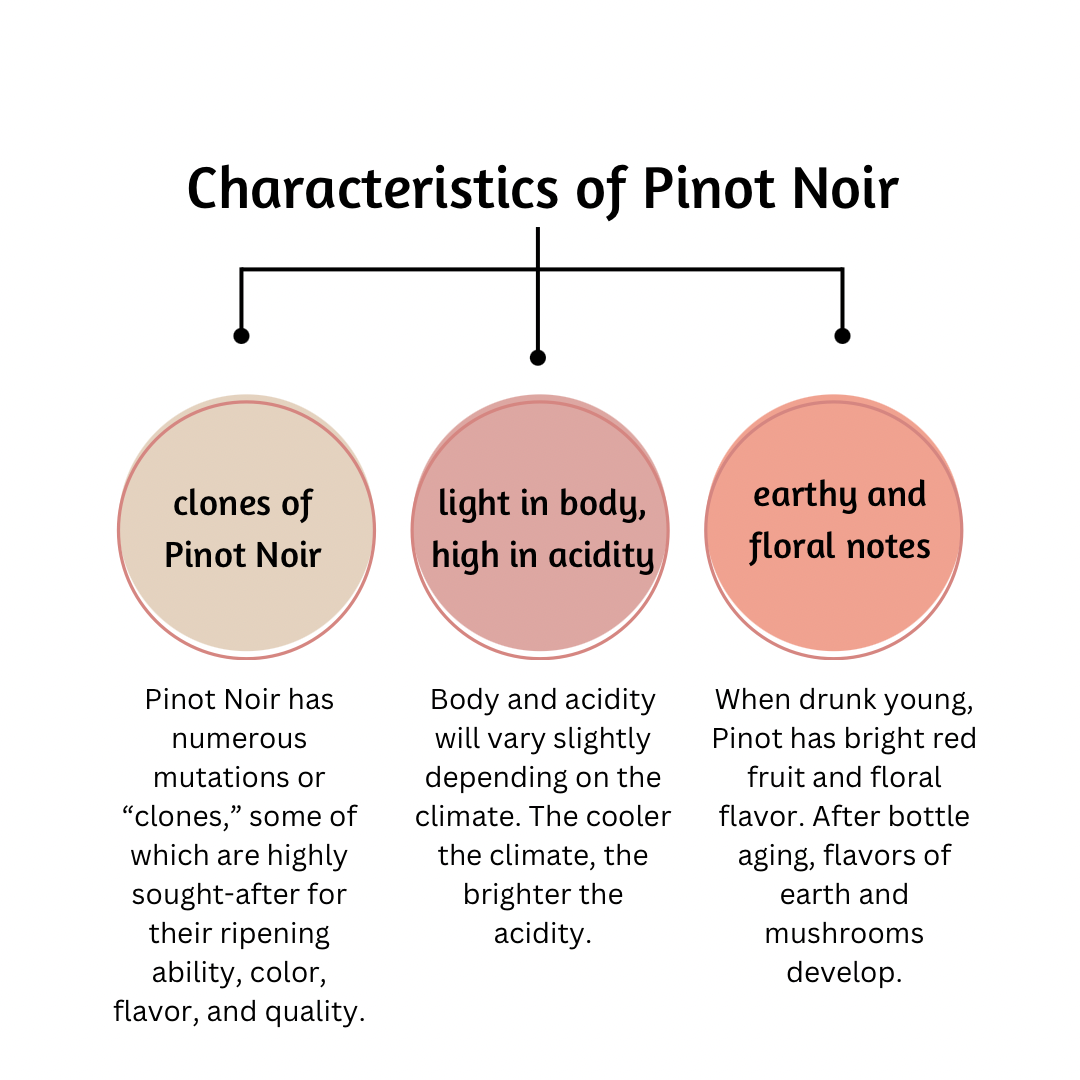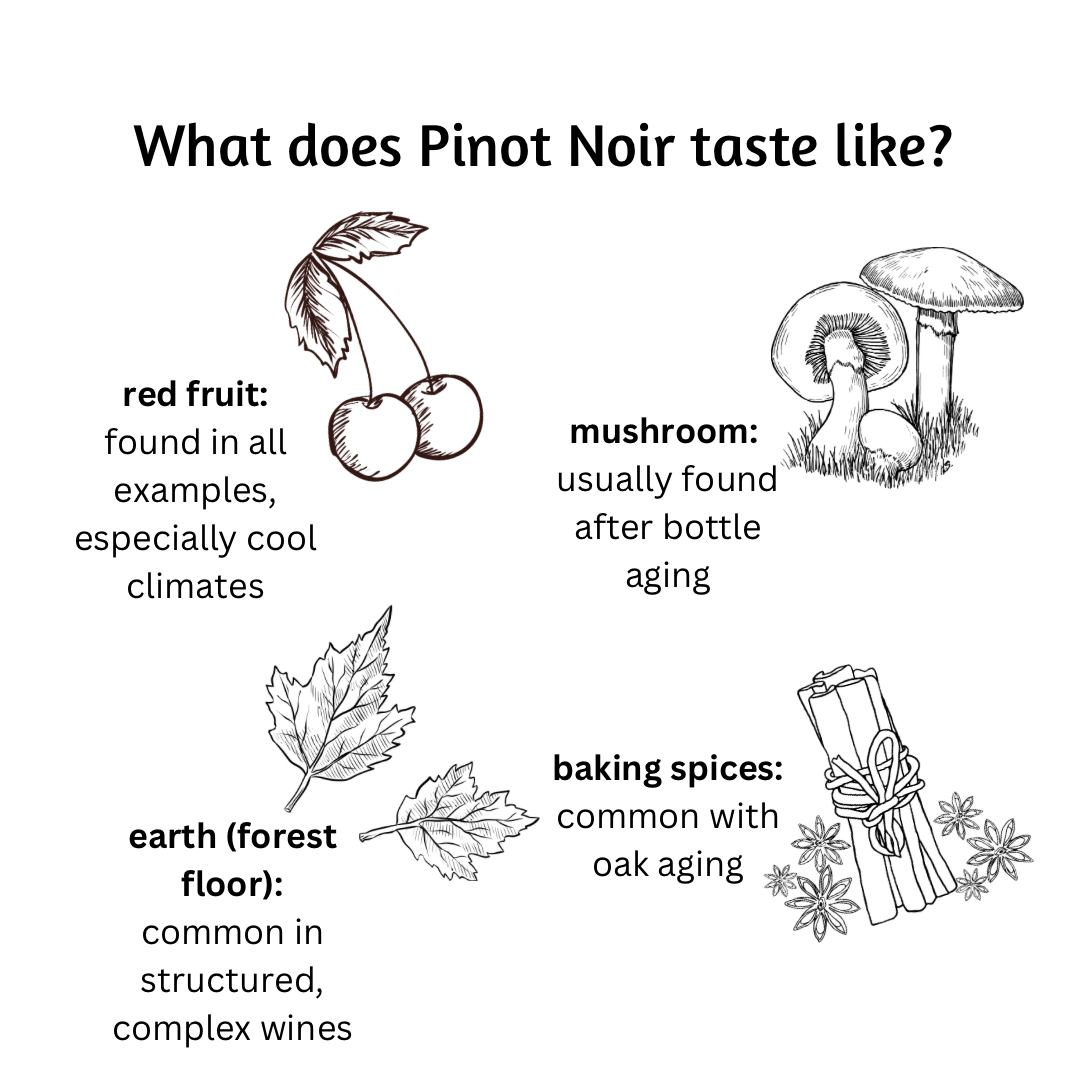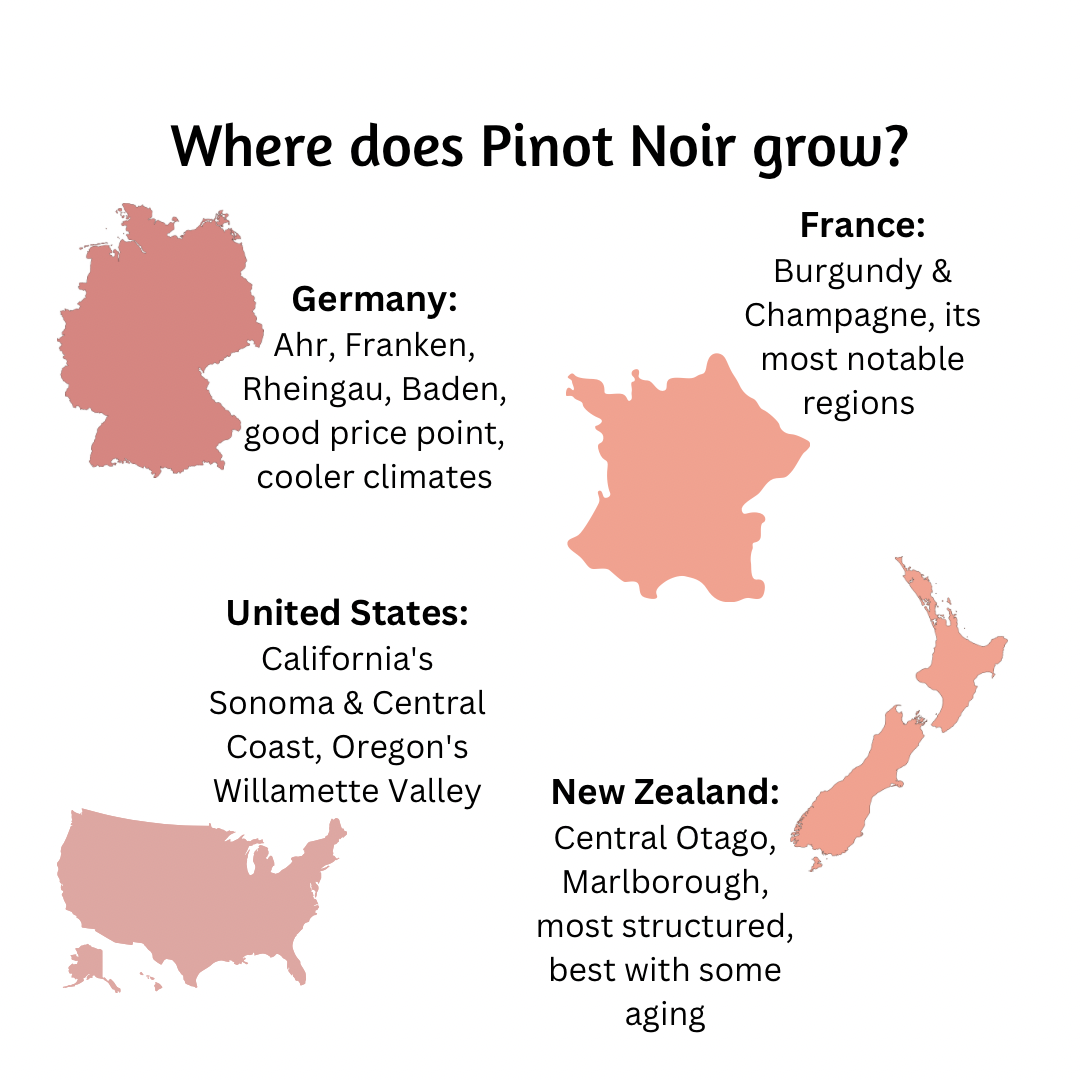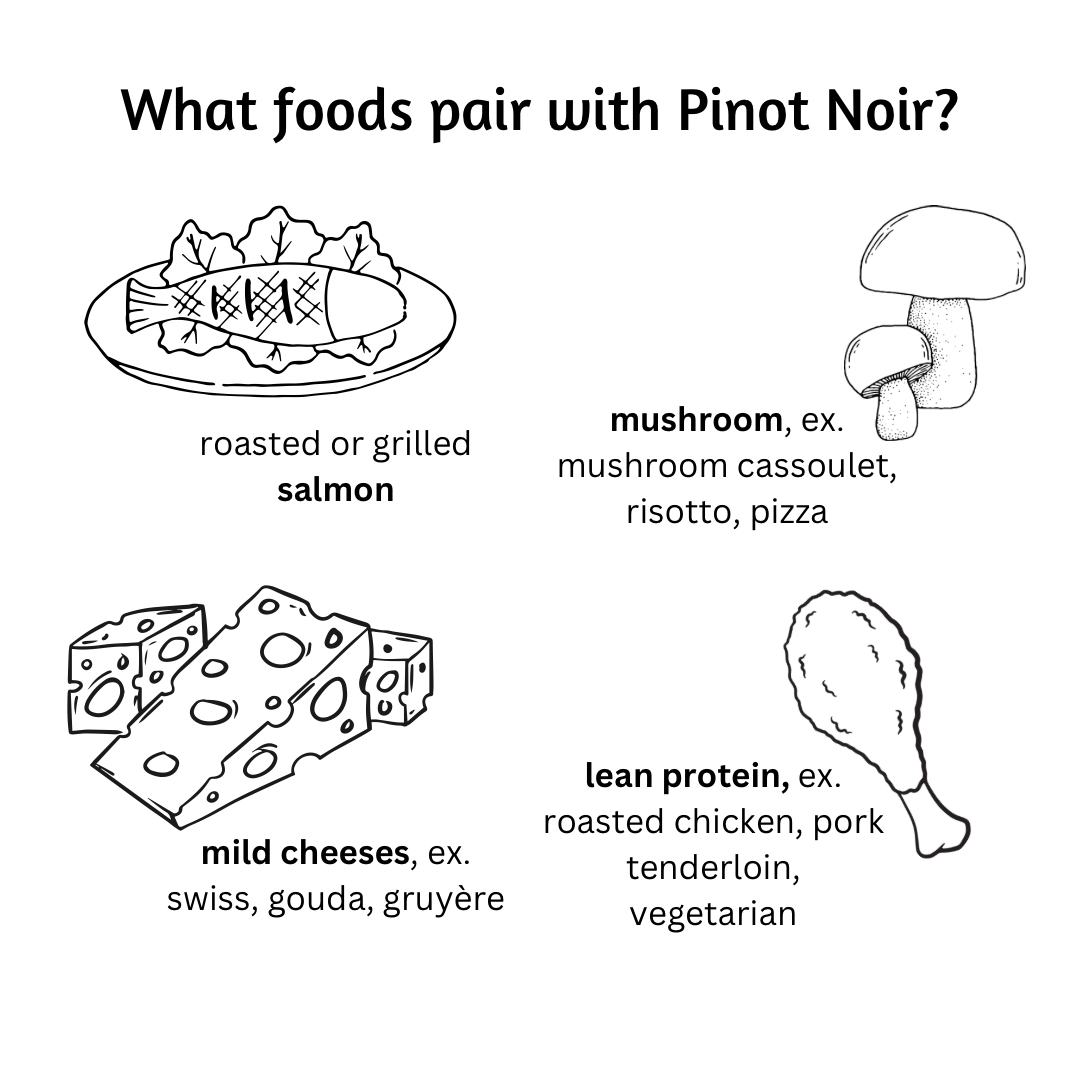Welcome to my quick guide on everything you NEED to know about Pinot Noir. I’ve got you covered with everything from characteristics to tasting notes, predominant growing regions, and food pairings!
Whether you love it or hate it, Pinot Noir is one of the most popular red wines in the world. With chameleon-like versatility and underestimated structure, it’s a diverse wine that is sure to taste unique depending on where and how it’s grown.
Flavors range from summertime red fruit to cranberry, cherry, mushroom, and forest floor. You’re going to be surprised at how many foods pair perfectly with Pinot Noir!
What I love about Pinot Noir: Its wide and ever-changing flavor profile! Pinot Noir can taste like flowers and strawberries, cherry cola, or trampled forest, depending on the climate, the winemaker’s methods, and aging. It’s no wonder it’s one of my favorite cheese-pairing wines.

Characteristics of Pinot Noir wine
Pinot Noir is a red wine made mainly in the Burgundy region of France, though its popularity has allowed it to be grown worldwide. It is made in a dry, still style, with one notable exception, but more on that later.
Because Pinot Noir is an old varietal that’s genetically unstable, it is predisposed to mutating into different “clones.” Some clones are more sought after than others for their ripening ability, color, flavor, and quality. Unfortunately, the clones are named rather sporadically, with names ranging from Pommard to Mount Eden, 777, 114, and 667. Don’t worry, there won’t be a quiz!
The flavor of Pinot Noir will vary depending on the climate and winemaking methods used. It is best grown in cool and moderate climates since warm climates lead to an unattractive cooked fruit flavor.
Pinot Noir is pale to medium in color, high in acid, low to moderate in tannins, and typically low in alcohol, around 11-13% ABV.
Aging Pinot Noir in large oak barrels is common, which helps to soften the wine without imparting too much oak flavor. It’s almost always found as a single varietal, except in Champagne, where it is blended with Chardonnay and or Pinot Munier.
Pinot is a wine best drunk young, though some premiere wines can benefit from aging anywhere from 1-5 years.

Pinot Noir tasting notes
The flavor and acidity of Pinot Noir will vary slightly depending on the climate and winemaking methods.
Cool climate Pinot Noir is generally higher in acidity and will have more bright red fruit flavor, lighter body, and be lower in alcohol. Cool climates include Burgundy and Oregon’s Willamette Valley.
Moderate climate Pinot Noir is going to make for slightly fuller-bodied wines with lower acidity, higher alcohol, and more flavors of cooked fruit. California and Chile are two examples of moderate climates for Pinot Noir.

Where is Pinot Noir Made?
Pinot Noir is grown in many wine regions because of its wide appeal and easy-drinking nature. That said, it’s most notably found in France, the United States, Germany, New Zealand, and Chile.
France
The birthplace of Pinot Noir and home to the most world-renown examples, some of which auction for hundreds, even millions, of dollars. The two main growing regions for Pinot Noir are Burgundy and Champagne.
Burgundy- Cooler climate makes for light-bodied Pinot with intense flavors of red cherry, white pepper, and earth. Here Pinot is known simply as “Burgundy” and is the main red grape in the region.
Champagne- Cool climate Pinot Noir is made here and is one of only three grapes permitted to make Champagne. Sweetness ranges from dry to sweet, and it can be found in both white and rosé. Flavors include lemon, bruised apple, brioche, cream, and toast.
California
Pinot has grown up and down California, though it’s found the most success in Sonoma, Central Coast, and the Russian River Valley.
Sonoma- Cooler climate with constant ocean breezes make for Pinot with high acidity and flavors of summertime red fruit, strawberry, cranberry, cherry, and subtle spice.
Central Coast- Moderate climate, making for more ripe and cooked red fruit flavors and slightly less acid. The Central Coast includes 40 smaller AVAs, including Paso Robles, Santa Barbara, and Monterey.
Russian River Valley- Cool climate, making Pinot with brighter acidity and flavors of cherry, boysenberry, and cranberry.
Oregon
I have a soft spot for Oregon’s Pinot, considering that was where I worked my first wine harvest! It’s a small but mighty region that’s quickly surpassed many others for producing exceptional Pinot.
Willamette Valley- A much cooler climate than any in California, making for vibrant, tart, and refreshing Pinot with flavors of red cherry, strawberry, cherry cola, and cinnamon.
Germany
Similarly to Riesling, Pinot Noir in Germany grows best in its cooler regions, where it is known as Spätburgunder. Being a country bordering France, this makes Germany a comparable region to Burgundy, at half the price.
Ahr, Franken, Rheingau, Baden- All moderate and dry climates, making for fruity wines with flavors of red cherry, cranberry, forest floor, and delicate allspice and cinnamon flavors.
New Zealand
This is New Zealand’s leading black grape and often requires some aging to reach its full potential, as wines here tend to be more ripe, dark, and structured.
Marlborough- Cooler climate, making for structured Pinot with vibrant flavors of ripe cherries, bramble, and baking spices.
Central Otago- Technically moderate in climate, Central Otago is known for having extreme cold and warm weather. This makes for ripe and richly flavored Pinot with medium acidity and medium tannins. Flavors range from spiced cherry to plum, white pepper, and raspberry.
Chile
Chile is still an up-and-coming wine region and has become a recent player in the world of Pinot. It’s found the most success in Casablanca Valley and San Antonio.
Warm days are relieved by cool ocean breezes and morning fog. This makes for refreshing Pinot with vibrant acidity and flavors of cooked strawberry, raspberry, and subtle floral flavor.

Pinot Noir Food Pairings
Pinot Noir is a wine equally suited for drinking poolside as it is for pairing with a variety of dishes and cuisines. Its vibrant acidity, coupled with unobtrusive tannins and delicate flavor profile, allows it to slip between dishes, unlike most wines.
One of my favorite food pairings with Pinot is salmon. Fish may have a reputation for being a “white wine only” dish, but the natural flavor of salmon takes very well to the bright and fruity nature of Pinot.
Mushrooms are another go-to since many examples of Pinot exhibit a savory, umami-like mushroom quality, especially after bottle aging. Other favorite pairings include all things vegetarian, lean proteins, and mild cheeses.
It’s best to avoid richly flavored dishes, smoked meats, and anything with a higher acidity than the wine itself, such as vinaigrettes or citrus.
Wines like Pinot
- Gamay Noir- light body, subtle tannins, similar flavor profile
- Corvina- high acidity, low in tannins, flavors of fresh red fruit, found in the Valpolicella region of Veneto, Italy
- Trollinger/Schiava- high acidity, low in tannins, floral and red fruit flavor
Want to learn more about wine?
I can not recommend The Wine Bible by Karen MacNeil enough. To date, I consistently refer to this book when creating content for myself and my clients. It’s reliable, easy to read, and remarkably well-written.

